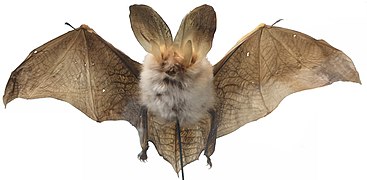| Brown long-eared bat | |
|---|---|

| |
| Conservation status | |
 Least Concern (IUCN 3.1) | |
| Scientific classification | |
| Domain: | Eukaryota |
| Kingdom: | Animalia |
| Phylum: | Chordata |
| Class: | Mammalia |
| Order: | Chiroptera |
| Family: | Vespertilionidae |
| Genus: | Plecotus |
| Species: | P. auritus |
| Binomial name | |
| Plecotus auritus (Linnaeus, 1758) | |

| |
| Synonyms | |
|
Vespertilio auritus Linnaeus, 1758 | |
The brown long-eared bat or common long-eared bat (Plecotus auritus) is a small Eurasian insectivorous bat. It has distinctive ears, long and with a distinctive fold. It is extremely similar to the much rarer grey long-eared bat which was only validated as a distinct species in the 1960s. An adult brown long-eared bat has a body length of 4.5–4.8 cm, a tail of 4.1–4.6 cm, and a forearm length of 4–4.2 cm. The ears are 3.3–3.9 cm in length, and readily distinguish the long-eared bats from most other bat species. They are relatively slow flyers compared to other bat species.

Habitat
The brown long-eared bat is found throughout Europe, with the exception of Greece, southern Italy and southern Spain. It is found to the east up to the Urals and Caucasus. The UK distribution can be found on the National Biodiversity Network website and can be seen here.
Brown long-eared bats regularly utilise buildings roosting in undisturbed roof spaces either singly, in crevices and timber, or in clusters around chimneys and ridge ends. This species also roosts in treeholes, bat boxes and caves which are important as winter hibernation sites. The roosts in trees may be close to the ground. Emergence from roost sites usually only occurs in the dark, around an hour after sunset.
It hunts above woodland, often by day, and mostly for moths, but its diet also consists of earwigs, flies, and beetles, gleaning these insects from leaves and bark. Prey is probably detected by sight and sound using the large eyes and ears, not by echolocation. A study by Eklöf and Jones (2003) demonstrated the ability of the brown long-eared bat to visually detect prey. Under experimental conditions, brown long-eared bats showed a preference for situations where sonar and visual cues were available. However, visual cues were more important than sonar cues and the bats were unable to detect prey items using only sonar cues. Brown long-eared bats have relatively large eyes and ears and it is likely that visual information and passive listening allow this species to detect prey in cluttered environments.
Echolocation
Echolocation is not used to find prey. The frequencies used by this bat species for echolocation lie between 27–56 kHz, have most energy at 35 kHz and have an average duration of 2.5 ms. However, unlike most bats, the long-eared can hunt their prey by hearing alone. Their hearing is sensitive enough to hear a moth in flight. This hunting strategy evolved because prey items, namely certain moth species evolved the ability to hear the echolocation and take evading action.
Gallery
-
 Drawing by Ernst Haeckel
Drawing by Ernst Haeckel
-
 Detail of head
Detail of head
-
 Woodcut from R. A. Sterndale, 1884
Woodcut from R. A. Sterndale, 1884
-
 Exemplar in the Oxford University Museum of Natural History
Exemplar in the Oxford University Museum of Natural History
-
 Romanian stamp
Romanian stamp
-

References
- Russo, D.; Cistrone, L. (2023). "Plecotus auritus". IUCN Red List of Threatened Species. 2023: e.T85535522A211015413. doi:10.2305/IUCN.UK.2023-1.RLTS.T85535522A211015413.en. Retrieved 12 January 2024.
- Linnæus, Carl (1758). Systema naturæ per regna tria naturæ, secundum classes, ordines, genera, species, cum characteribus, differentiis, synonymis, locis. Tomus I (in Latin) (10th ed.). Holmiæ: Laurentius Salvius. p. 32. Retrieved 22 November 2012.
- "Plecotus auritus", Science for Nature Foundation
- Russ, J. (1999). The Bats of Britain and Ireland. Echolocation calls, sound analysis, and species identification. Powys: Alana Books.
- "Brown long-eared bat".
- Eklöf, J.; Jones, G. (2003). "Use of vision in prey detection by brown long-eared bats, Plecotus auritus". Animal Behaviour. 66 (5): 949–953. doi:10.1006/anbe.2003.2272. S2CID 53194611.
- "The Bats of Britain". www.bio.bris.ac.uk. Retrieved 2017-03-16.
- Parsons, S. and Jones, G. (2000). "Acoustic identification of twelve species of echolocating bat by discriminant function analysis and artificial neural networks". J Exp Biol. 203 (Pt 17): 2641–2656. doi:10.1242/jeb.203.17.2641. PMID 10934005.
{{cite journal}}: CS1 maint: multiple names: authors list (link) - Obrist, Martin K.; Boesch, Ruedi; Flückiger, Peter F. (2004). "Variability in echolocation call design of 26 Swiss bat species: consequences, limits and options for automated field identification with a synergetic pattern recognition approach". Mammalia. 68 (4): 307–322. doi:10.1515/mamm.2004.030. S2CID 86180828.
- Sources
- Woodland Management For Bats Guide Archived 2013-03-19 at the Wayback Machine
- Gazaryan, S.; Kruskop, S.V.; Godlevska, L. (2020). "Plecotus auritus". IUCN Red List of Threatened Species. 2020: e.T85535522A195861341. doi:10.2305/IUCN.UK.2020-2.RLTS.T85535522A195861341.en. Retrieved 11 November 2021.
- Stevens, Martin (2005): The role of eyespots as anti-predator mechanisms, principally demonstrated in the Lepidoptera. Biol. Rev. 80(4): 573–588. doi:10.1017/S1464793105006810 (HTML abstract)
External links
- ARKive Photographs
| Taxon identifiers | |
|---|---|
| Plecotus auritus |
|
| Vespertilio auritus | |